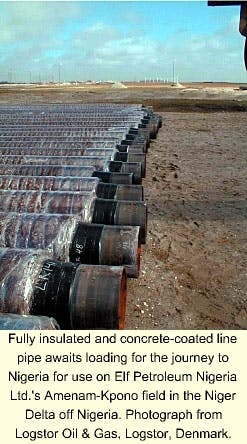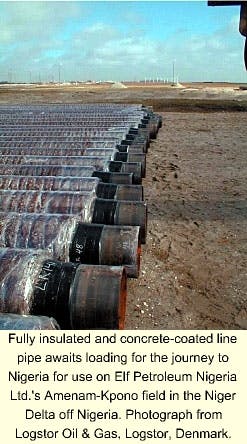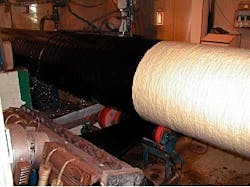In September 2001, Elf Petroleum Nigeria Ltd. (EPNL) will begin taking delivery of thermally insulated and weight-coated line pipe for its Amenam-Kpono field project in the Niger Delta off the coast of Nigeria.
Coating and insulation were completed in May by Logstor Oil & Gas, division of Logst r R r AS, Logst r, Denmark; weight coating is underway at Vibrodens AS's plant at the harbor of Esbjerg in the southern part of Denmark. This step will take 21 weeks.
Installation in Nigeria will occur early next year, says Logstor.
Amenam-Kpono
The Amenam-Kpono field straddles offshore blocks OML 99 (operated by EPNL for the Nigerian National Petroleum Co./EPNL joint venture) and OML 70 (operated by Mobil Producing Nigeria in an NNPC/MPN joint venture) in waters 40 m deep. - One joint of line pipe moves through the insulating and coating process, receiving an HDPE layer over a layer of polyurethane foam. Photograph from Logstor Oil & Gas, Logstor, Denmark.
EPNL is unit operator on the Amenam-Kpono field, in which NNPC owns a 60% interest. Although EPNL and MPN's interests will be determined in a future unitization agreement currently under discussion, initial interests are 31.2% for EPNL and 8.8% for MPNU.
The field was discovered in 1990 with the well AMN-1 drilled by the NNPC/EPNL joint venture on OML 99. The NNPC/MPNU joint venture confirmed continuation of the field into OML 70 with the drilling of KPN-1 in 1995. The reservoirs lie at depths greater than 3,500 m below the sea level, says Logstor.
Almost 500 million bbl of oil will likely be produced for an investment of about $1 billion. Production from the field will be evacuated through a pipeline linking the production platform to the floating storage and offloading (FSO) terminal on EPNL's Odudu field in OML 100.
In December 2000, Logstor Oil & Gas signed a contract to insulate and weight coat the subsea pipeline system with Logstor's single-pipe system based on polyurethane foam.
The 40-km subsea pipeline will connect three platforms installed at water depths from 40 to 70 m. The pipeline consists of two pipe systems: a 16-in. pipeline (34.8 km) and a 24-in. pipeline (4.8 km) connecting the three platforms. Temperature of the fluid is a maximum 90° C.
Insulation
The overall U-value requirements (overall heat transfer coefficient) for the 16-in. pipe was 3.19 w/sq m-°K. (0.56 btu/sq ft-hr-°F.), and Logstor says it has supplied a pipe within a U-value of 2.0 w/sq m-°K.
The U-value requirements for the 24-in. pipeline was 2.6 w/sq m-°K., and Logstor supplied a pipe with an U-value of 1.70 w/sq m-°K.
The single pipe element, says Logstor, consists of a 16-in. OD, 9.53-mm WT API 5L X-65 inner pipe and a 465-mm OD high-density polyethylene (HDPE) pipe directly extruded on the 20-mm polyurethane foam layer.
The other pipe element consists of a 24-in., 14.3-mm WT API 5L X-65 inner pipe and a 775-mm OD HDPE pipe directly extruded on the 28-mm polyurethane foam layer.
The inner pipes were anticorrosion protected with a 3-mm polypropylene coating. The outer HDPE pipe is directly extruded onto the polyurethane foam and in each end a sealing material is applied in-line forming a water stop in each end of the pipe. This makes it a very safe pipe system to use, says Logstor.
The company successfully tested the water-stop design in a pressure tank while the temperature was cycled between 90° C. and 15° C.
The polyurethane foam is sprayed onto the pipe while it rotates in a spiral movement forwards. The density is 180 kg/cu m and the k-value 0.039 w/m-°K.
The foam is strong enough to withstand hydraulic pressure at 70 m water depth (7 bar). The polyurethane foam is also able to sustain a temperature of 90° C. for a minimum lifetime of 25 years, said the supplier.
Field joint coatings will be performed on the lay barge by injecting foam.
Installation will be performed by S-lay from Stolt Offshore SA's lay barge Polaris.




